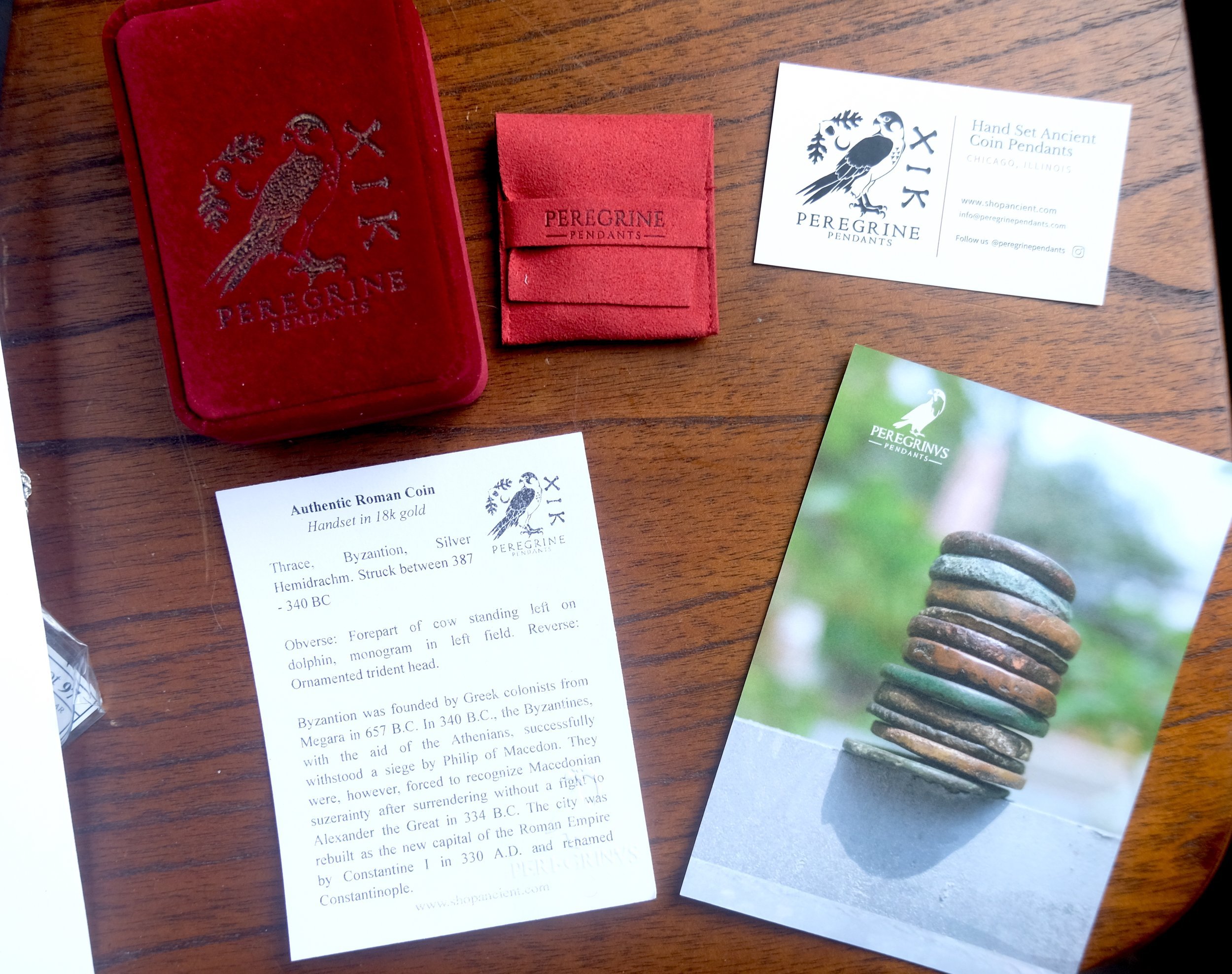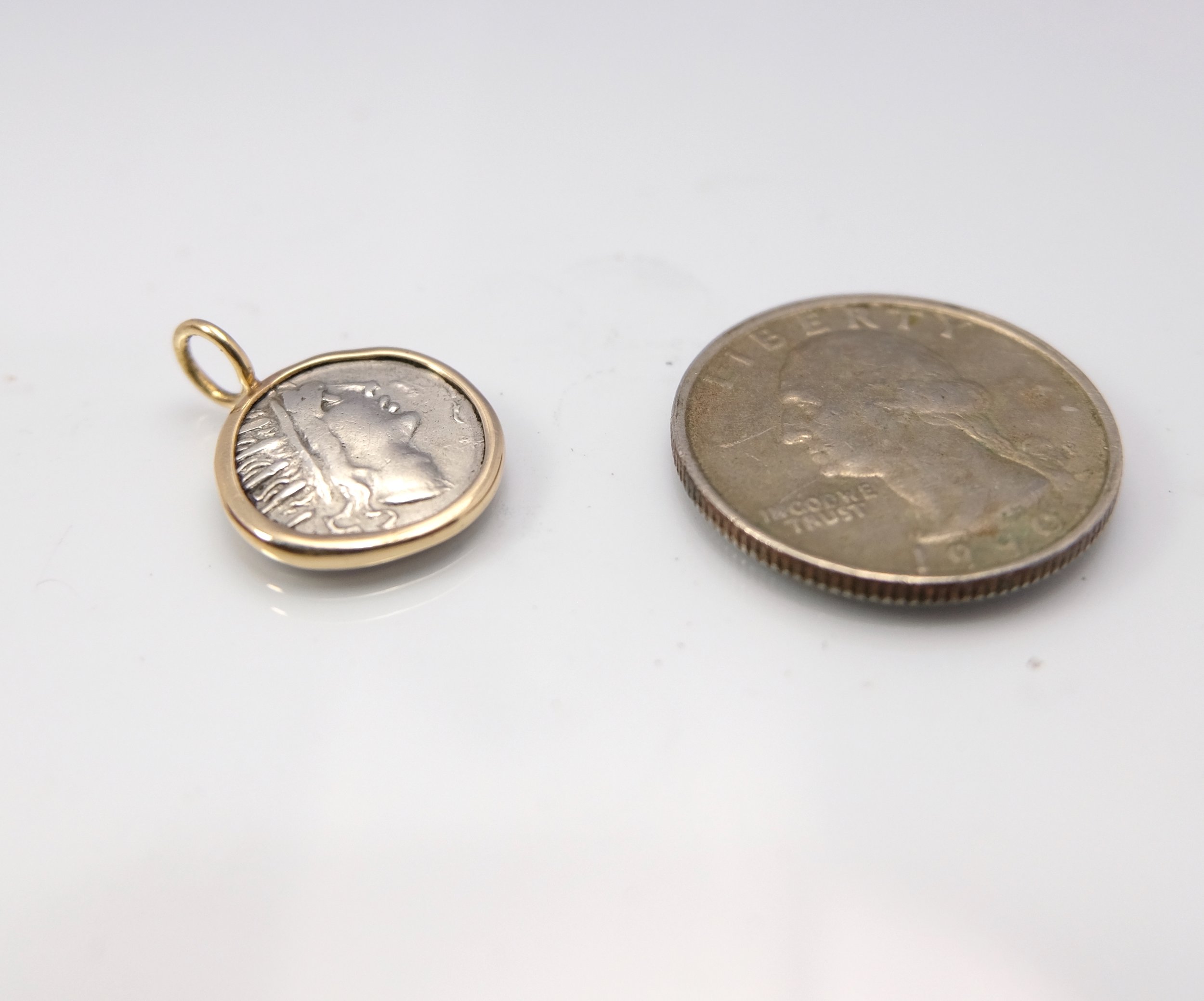 Image 1 of 5
Image 1 of 5

 Image 2 of 5
Image 2 of 5

 Image 3 of 5
Image 3 of 5

 Image 4 of 5
Image 4 of 5

 Image 5 of 5
Image 5 of 5






1856 Indian Princess Gold Dollar hand set in 18k gold
Stunning gold coin struck in 1856 hand set in 18k gold bezel. The pendant measures 15 mm in width, and 21 mm from top to bottom. See picture for scale. The coin shows an "Indian Princess".
Gold dollars are often sold in clunky pre made bezels. This coin was first set in a gold bezel, which was then hammered over the edge of both sides. This was then sanded and polished. This pendant was built to last.
Chains are sold separately.
The Gold Dollar denomination was struck from 1849 to 1889 and over that 40 year period we saw 3 different design types produced. This denomination also happened to be the smallest piece of gold coinage in size ever created by the U.S. Mint. The Coinage Act of 1849 included production of the popularly known Double Eagle but also the Gold Dollars. The reason for this act that resulted in the minting of these new gold coins was the famous California gold rush. The U.S. government felt why not use this newly found gold as currency. This new Gold Dollar was designed by James B. Longacre and then struck and distributed out of five different mints. These mints include Philadelphia San Francisco, New Orleans and the lesser known and short lived gold-only mints of Charlotte and Dahlonega. Just as the public would complain of large coins being too heavy and difficult to carry around, they also found fault with small coinage as well. The major reason for design changes for the Gold Dollar denomination was the complaint that their minimal stature caused many people to mishandle them or simply misplace them all together. Contrary to that, many collectors today find the acquisition of or dealing in Gold Dollars to be quite fun. They are small, beautifully designed coins that a worn, raw, common example can be found for just a few hundred dollars but most methods of collecting, investing and dealing can be extremely costly. Basically all C and D minted Gold Dollars are rarities as well as the 1875 Philadelphia and of course all proofs produced in Philly as well. As one would expect, Mint State pieces are very scarce and valuable but it is important to note that later issues are far more common and type collector friendly than earlier dates. Collectors should look for premium luster, original yellow-gold coloration and absolutely no signs of damage such as scratches or even pieces that have been removed from jewelry.
Stunning gold coin struck in 1856 hand set in 18k gold bezel. The pendant measures 15 mm in width, and 21 mm from top to bottom. See picture for scale. The coin shows an "Indian Princess".
Gold dollars are often sold in clunky pre made bezels. This coin was first set in a gold bezel, which was then hammered over the edge of both sides. This was then sanded and polished. This pendant was built to last.
Chains are sold separately.
The Gold Dollar denomination was struck from 1849 to 1889 and over that 40 year period we saw 3 different design types produced. This denomination also happened to be the smallest piece of gold coinage in size ever created by the U.S. Mint. The Coinage Act of 1849 included production of the popularly known Double Eagle but also the Gold Dollars. The reason for this act that resulted in the minting of these new gold coins was the famous California gold rush. The U.S. government felt why not use this newly found gold as currency. This new Gold Dollar was designed by James B. Longacre and then struck and distributed out of five different mints. These mints include Philadelphia San Francisco, New Orleans and the lesser known and short lived gold-only mints of Charlotte and Dahlonega. Just as the public would complain of large coins being too heavy and difficult to carry around, they also found fault with small coinage as well. The major reason for design changes for the Gold Dollar denomination was the complaint that their minimal stature caused many people to mishandle them or simply misplace them all together. Contrary to that, many collectors today find the acquisition of or dealing in Gold Dollars to be quite fun. They are small, beautifully designed coins that a worn, raw, common example can be found for just a few hundred dollars but most methods of collecting, investing and dealing can be extremely costly. Basically all C and D minted Gold Dollars are rarities as well as the 1875 Philadelphia and of course all proofs produced in Philly as well. As one would expect, Mint State pieces are very scarce and valuable but it is important to note that later issues are far more common and type collector friendly than earlier dates. Collectors should look for premium luster, original yellow-gold coloration and absolutely no signs of damage such as scratches or even pieces that have been removed from jewelry.
Stunning gold coin struck in 1856 hand set in 18k gold bezel. The pendant measures 15 mm in width, and 21 mm from top to bottom. See picture for scale. The coin shows an "Indian Princess".
Gold dollars are often sold in clunky pre made bezels. This coin was first set in a gold bezel, which was then hammered over the edge of both sides. This was then sanded and polished. This pendant was built to last.
Chains are sold separately.
The Gold Dollar denomination was struck from 1849 to 1889 and over that 40 year period we saw 3 different design types produced. This denomination also happened to be the smallest piece of gold coinage in size ever created by the U.S. Mint. The Coinage Act of 1849 included production of the popularly known Double Eagle but also the Gold Dollars. The reason for this act that resulted in the minting of these new gold coins was the famous California gold rush. The U.S. government felt why not use this newly found gold as currency. This new Gold Dollar was designed by James B. Longacre and then struck and distributed out of five different mints. These mints include Philadelphia San Francisco, New Orleans and the lesser known and short lived gold-only mints of Charlotte and Dahlonega. Just as the public would complain of large coins being too heavy and difficult to carry around, they also found fault with small coinage as well. The major reason for design changes for the Gold Dollar denomination was the complaint that their minimal stature caused many people to mishandle them or simply misplace them all together. Contrary to that, many collectors today find the acquisition of or dealing in Gold Dollars to be quite fun. They are small, beautifully designed coins that a worn, raw, common example can be found for just a few hundred dollars but most methods of collecting, investing and dealing can be extremely costly. Basically all C and D minted Gold Dollars are rarities as well as the 1875 Philadelphia and of course all proofs produced in Philly as well. As one would expect, Mint State pieces are very scarce and valuable but it is important to note that later issues are far more common and type collector friendly than earlier dates. Collectors should look for premium luster, original yellow-gold coloration and absolutely no signs of damage such as scratches or even pieces that have been removed from jewelry.
All coin jewelry comes with the following items:
- Certificate which guarantees authenticity and provides background information (listed below) on the acquired coin(s)
- Sterling silver chain and jewelry pouch
You Might Also Like

























